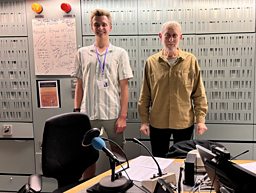My Stammer Story β one manβs inspirational journey in overcoming a stammer

For the first ten years of his life, William Laven went to speech therapy with a stammer that was so severe he could not form a full sentence. Fast forward to today, and the 23-year-old is a podcast founder, Tedx speaker, stammer advocate, awareness raiser and campaigner. He is devoted to improving expectations for those with speech impediments, challenging the stigma surrounding stammers, and encouraging children with stammers to believe in themselves.
On Word of Mouth, he talks to Michael Rosen about how he has learnt to embrace language and life with a stammer, and how a stammer isn’t a barrier to pursuing your dreams.
βI had speech therapy for the first ten years of my life.β
“I was very delayed saying my first few words, so my parents new that something wasn’t right,” William recounts. At around three or four years old, they took him to see a speech therapist. “I had speech therapy for the first ten years of my life. Every single week… I can still, sadly, memorise the exact room,” says William. Over time, his stammer improved through the therapy, but, he says, “I’ve never known a day without stammering.”
No one should be afraid of using their voice as a child.
“School was very tough for me.”
When they did the class register, the other children would rattle off their names, then, when it came to his turn, “the whole room would just go silent,” says William. “I couldn’t say my name without stammering.”
His close friends were amazingly supportive, but others were less kind. “I had some pretty nasty things that were said,” he recalls. “I had someone say, ‘What’s wrong with your voice? Why can’t you say your name? Why can’t you speak properly?’” Some would imitate his stammer. A day rarely went by when someone didn’t mention it.
“Having that at such a young age is tough,” says William. “No one should be afraid of using their voice as a child.” Unfortunately, his experience is not unique. “It’s harder for you to have the confidence to speak up when you know you could get bullied or laughed at, so lots of young people with stammers lead quite a silent childhood, which is so sad.”
At secondary school, his stammer got worse
On leaving primary school, William was told that the speech therapy he’d had for a decade was no longer available to him. “It’s quite scary when you get told, OK, you’re basically by yourself now,” he says. It was down to him to use the techniques he’d been taught.
The move to secondary school was daunting. His primary school had around 70 students but the new college had 4,000. “I didn’t really know if they’d experienced a neurodiverse person before,” he says. And he was unsure how he’d cope with the crowds. “All that anxiety made my stammer worse.”
He went back to his GP to seek help for what was now a “severe” stammer. And that’s when he was referred to the Michael Palin Centre, set up by the Monty Python actor (whose own father had a stammer), to help young people like William.
βThat centre has changed my life massively.β
“It was the first time that I’d been surrounded by people with a stammer, but also people my own age,” says William. It provided a “wake-up call”: that he wasn’t the only person who stammers and that every stammer is different.

He was taught techniques to prepare him for adult life, not just the classroom. “They made us go into public and ask for directions, which is absolutely terrifying, especially when you’ve got a stammer,” he says.
They got taught the Camperdown method. This involves slowing your speech right down, and then gradually speeding it up to a point where you can speak in a public setting, without anyone knowing that you are using a technique.
“I stammer way more in my head than you may think I’m stammering.”
These techniques have helped William to disguise his stammer, but in his own head he knows he’s stammering more than it outwardly appears. “You’d be surprised by how many people have the internal stammer,” he says.
He knows he stammers with some words and not others, so he goes through his vocab and quickly changes words when he’s speaking. When preparing a presentation, he takes care to select “stammer friendly words”. The process is exhausting. “I don’t think people realise that about stammering. There’s that constant pre-think of our sentences,” he says. “It’s quite tiring because you’re overthinking everything.”
And there’s only so much preparation he can do. “It’s like a jackpot,” he says. He never knows exactly when he’s going to stammer or how frequently. “I could go a whole day without stammering whatsoever. Or I could stammer once a sentence, for a week.”

βI know that Iβm going to stammer for the rest of my life.β
“Mine’s sort of like a covert stammer where I know that I’m going to stammer for the rest of my life,” says William. But he’s now more fluent, more aware of aspects of his stammer, and he knows how to cope.
The more you own it, the less likely youβll stammer.
Rather than fighting it, he’s learnt to embrace it as part of him. “Why should I let myself get down about something that’s going to be a life-long thing,” he says. “It’s unique.” If he was to hide his stammer, he wouldn’t be his “true self”.
At the same time, he doesn’t want to be defined by it. “We don’t judge people’s accents,” he states. “Why pity us because of the way that we stammer? And don’t define us because of that.”
He started a podcast to provide a platform.
During lockdown, going from a busy office to working from home, William realised he was stammering on new words. He decided to start a podcast, to share his own story, to show others they weren’t alone, and build his confidence, but also provide a platform for people who stammer to share their inspiring stories. His guests include people who stammer who do amazing things in their own field, people in the stammering field like speech therapists, “but also”, he says, “a very important aspect is talking to people who don’t stammer to show that society is accepting.”
One guest was former politician Ed Balls, who only realised he had a stammer in his forties, whilst he was in cabinet. After seeing a speech therapist, who advised him to speak openly about it, he went public. “He said it was one of the best things he did,” says William. He’s now the Vice President of Action for Stammering Children and, like William, seeking to raise awareness.
Other βstambassadorsβ.
The British Stammering Association is campaigning for more representation of stammering in the media. “People see the TV and they think, oh that person’s fluent, I’ll never be able to be a news presenter, or I’ll never be able to have my own YouTube channel. But actually, you can,” says William.

Perhaps the world’s most high profile stammerer is the President of the United States, Joe Biden, who spoke openly about it during his campaign. “In his inauguration, nearly every speaker who he had had a speech impediment of some sort,” says William, “to represent it.”
Ed Sheeran has had a stammer his whole life, and he did a CBeebies bedtime story on International Stammering Awareness Day. It’s an inspiration to young people, to know that such a huge star has a stammer too, says William.
“It needs to be spoken about because there are so many people out there doing amazing things but you just wouldn’t know that they have a stammer,” says William.
A message to other young people with stammers.
“The biggest thing is just to own it, embrace it, because it makes you the person who you are today,” says William. “What’s the good in letting it hold you back when actually you’d be surprised by how much you can achieve?” Your stammer shouldn’t stop you from getting your dream job: “It’s not about your stammer, it’s about you as a person.” Go out there and push yourself, he says.
And finally, talk about it. “The more you talk about it, the more comfortable you are with it,” says William. “The more you’re open about it, the more you own it, the less likely you’ll stammer.”
-
![]()
Word of Mouth: My stammer story
Michael Rosen asks William Laven about how he has learned to embrace language and life with a stammer, which he now believes is his superpower!

A world of words on Radio 4
-
![]()
Word of Mouth
Series exploring the world of words and the ways in which we use them, with Michael Rosen.
-
![]()
Dropping the mic and jumping the shark
Michael Rosen and Gareth Carrol, author of Jumping Sharks and Dropping Mics, discuss modern idioms and where they come from.
-
![]()
Coinages that changed the world β and some that tried to...
Exploring the hidden histories of obscure words, and common buzz phrases.
-
![]()
Ittibitium, borborygmus, and Ba humbugi β 14 wonderful science words youβve never heard of
Michael Rosen puts the language of science under the microscope.





